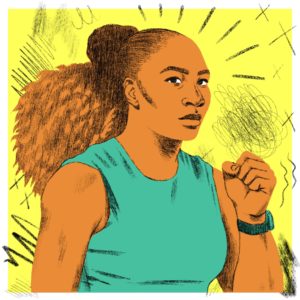IN HER WORDS
Taking Back ‘Hysterical’
Serena Williams’s new all-female Nike ad, “Dream Crazier,” hit on an issue almost as old as time: the “hysterical” woman.
By Maya Salam Feb. 26, 2019
“If they want to call you crazy, fine. Show them what crazy can do.”
— Serena Williams, in a new Nike ad about women in sports
There is probably no better woman than Serena Williams to lead the charge of reclaiming the word “crazy.” In the past six months, she’s been penalized, fined and criticized for what she has said, has done, has worn and looks like — being called “crazy” by detractors all the while.
Her ability to flourish in spite of it has further endeared her to her legion of supporters, so it was no surprise when fans went, well, crazy on Sunday night when Williams’s new all-female Nike ad, “Dream Crazier,” premiered during the Oscars. (It’s already racked up over six million views on YouTube.)
The spot is a montage of some of the world’s greatest athletes doing what they do best, and defying authority while they do it. Williams, narrating, says women who express their emotions, their passion and their opinions have been called dramatic, nuts, delusional, unhinged, hysterical, irrational or crazy — seemingly reaching beyond the sports world to how women in all walks have been treated throughout time.
Women being labeled hysterical or crazy as a way to degrade them dates back centuries. “Hysteria” — which comes from the Greek word for womb, hystera — was one of the first mental health conditions attributed to only women.
“The idea was that any emotional display beyond the fairly tight boundaries of what was acceptable could be called hysteria,” Elaine Showalter, a feminist scholar who wrote an essay titled “Hysteria, Feminism and Gender,” told me this week.
(For example, newly released letters revealed that Charles Dickens tried to have his wife, the mother of his 10 children, imprisoned in an asylum while he pursued an affair. He claimed his wife’s “excitability” as sufficient basis for “moral insanity,” which at the time it was.)
The real politicization of the word, Showalter said, began around 1890 with the early suffrage movement and the rise of “the new woman”: an independent, challenging, confident, adventurous woman who laid claim to her emotions.
“That’s what the ad was getting at,” said Showalter, who is professor emerita of English at Princeton University.
During that time, hysterical and crazy were used mostly against two groups of women: those demanding entry to universities, particularly medical schools (“they’re going to overwork their brains” was an argument) and women who spoke publicly (they were seen as “abnormal, threatening and repulsive,” according to Showalter).
“Speaking out in public was so taboo and considered so unfeminine, any form of it was denounced as hysterical,” Showalter said.
Sound familiar? In 2017, Senator Kamala Harris was called “hysterical” by the former Trump aide Jason Miller for doing her job. (During a hearing, senators on the Senate Intelligence Committee, including Harris, were each allotted time to ask Jeff Sessions, then attorney general, about his involvement with Russians during the 2016 election.) When pressed as to how she was hysterical, Miller replied, “I mean, she was asking some tough questions.”
Serena Williams has long encouraged young women to assert themselves — echoing leaders of the past. Experienced suffragists would embolden younger women, Showalter said. “They’d say: ‘Don’t be afraid, you’re going to have to do it. You go out and speak in public, speak your mind and really say what you mean to say.’”

